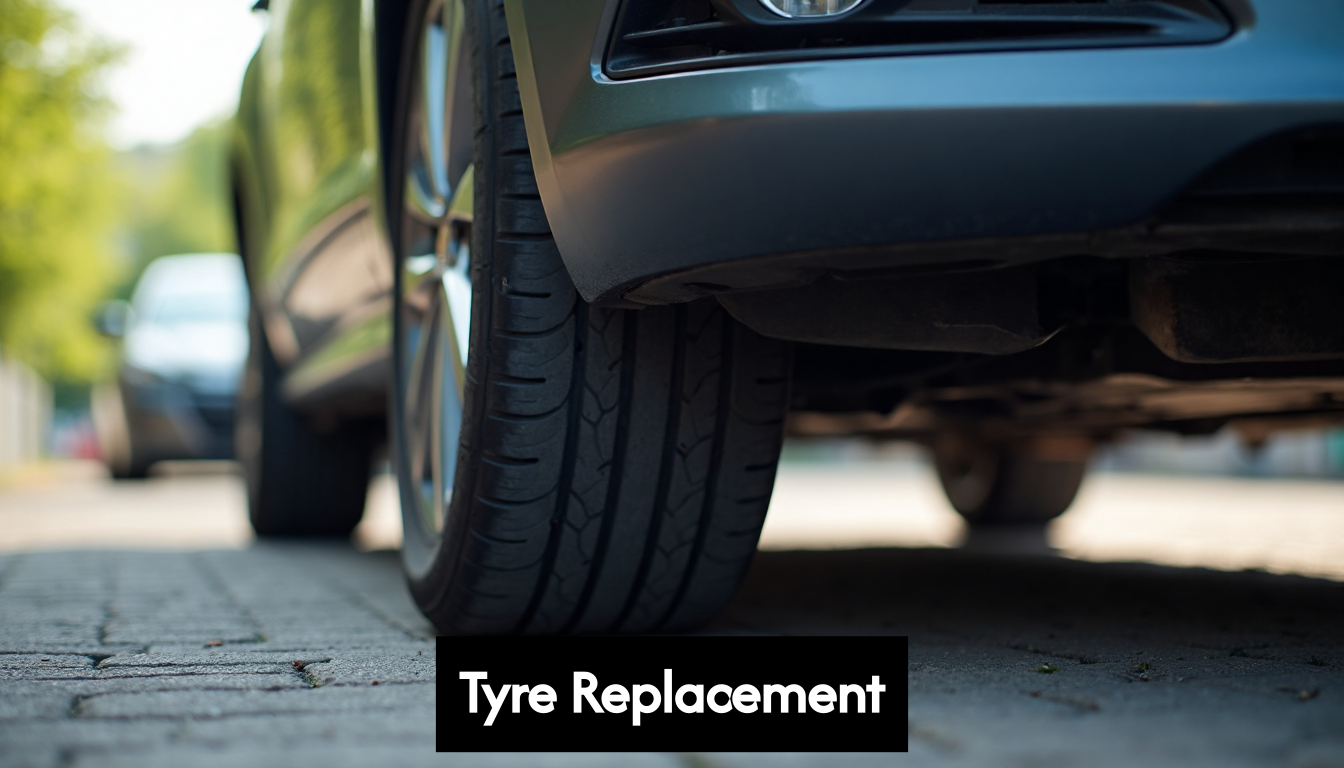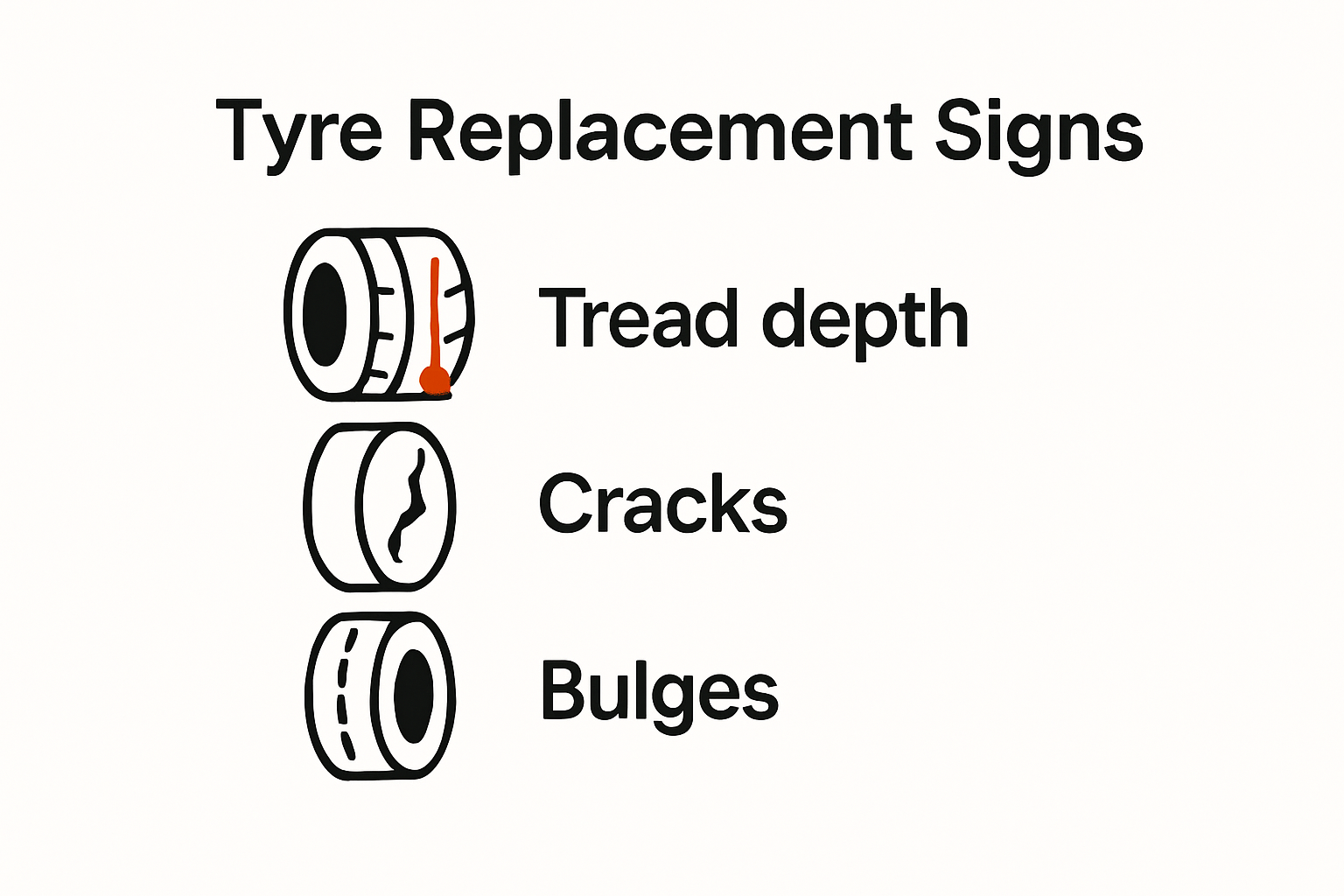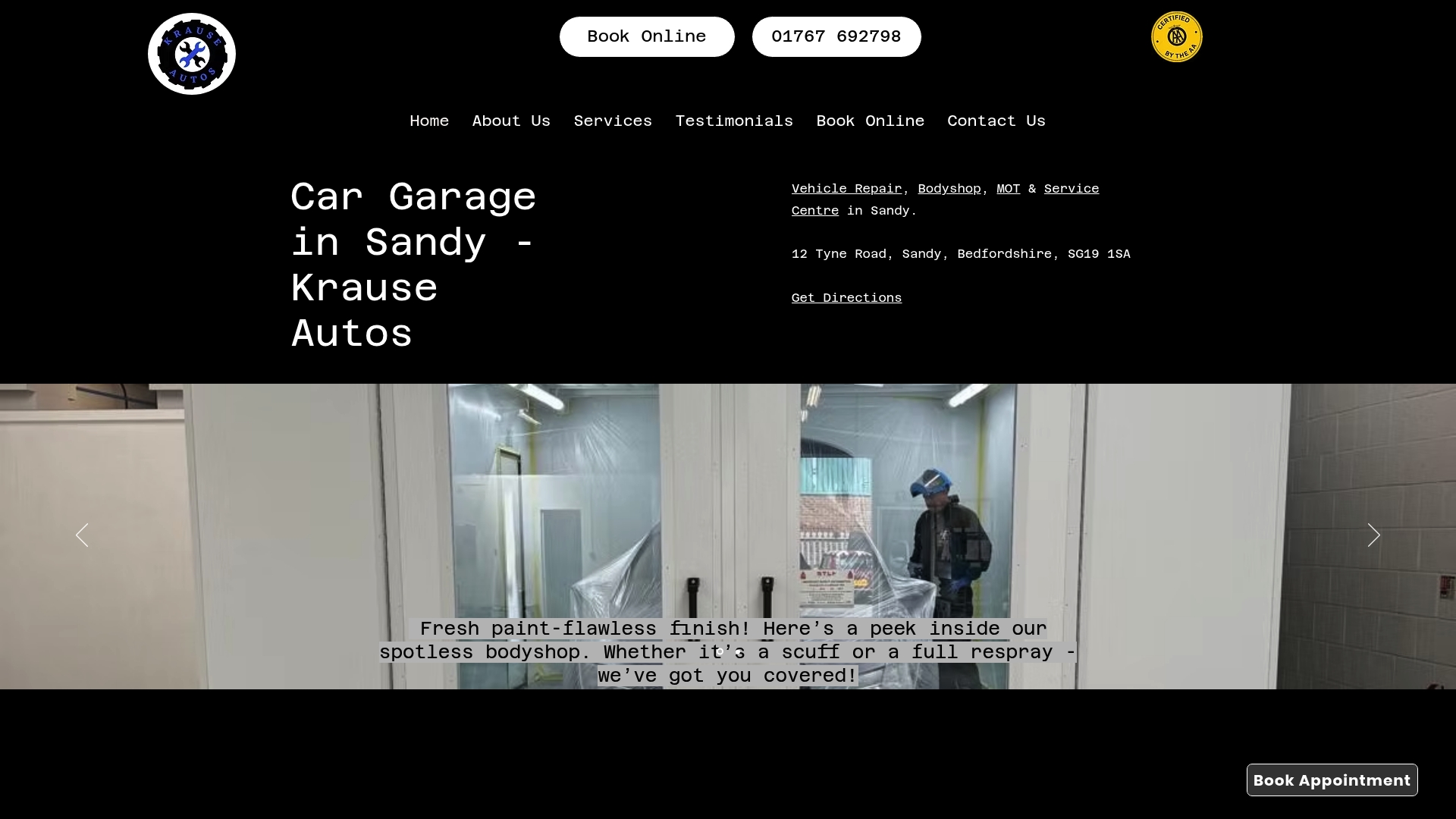Top Car Tyre Replacement Signs Every Driver Should Know (2025)
- coledem
- Jun 20
- 9 min read
Updated: Jun 22
Spotting worn tyres is more than a routine check. With an estimated 33,000 UK accidents caused by tyre failures every year, ignoring the warning signs is a gamble most drivers unknowingly take. Surprising as it sounds, plenty of tyres look fine but are dangerously close to a blowout or sudden loss of control. The most obvious clues aren’t just about treads or age, so what you discover next could save far more than just your wallet.
Table of Contents
Quick Summary
Common Car Tyre Replacement Signs to Watch For
Typical car tyres are designed to endure significant road challenges, but understanding the critical signs of wear and potential failure is crucial for every driver’s safety. Recognising when your tyres need replacement can prevent dangerous roadside incidents and costly vehicle damage.
Tread Depth: The Primary Indicator of Tyre Health
Tread depth is the most fundamental measure of tyre condition. Legally, UK vehicles must maintain a minimum tread depth of 1.6 millimetres across the central three-quarters of the tyre. However, automotive safety experts recommend replacing tyres well before reaching this absolute minimum. Professional mechanics suggest that once tread depth drops below 3 millimetres, your tyres’ performance significantly deteriorates, especially in wet conditions.
To check tread depth, drivers can use several methods. The simplest is the 20 pence coin test: insert the coin into the tyre’s tread groove. If the outer band of the coin remains visible, your tyres likely need replacement. For more precise measurements, invest in a dedicated tread depth gauge or consult our tyre pressure guide for comprehensive tyre maintenance advice.
Visual Signs of Tyre Wear and Damage
Beyond tread depth, visual inspection reveals critical replacement signs. Look for these key indicators:
- Sidewall Cracks
: Visible cracks or splits in the sidewall suggest structural weakness
- Bulges or Blisters
: Irregular protrusions indicate potential imminent tyre failure
- Uneven Wear Patterns
: Suggests alignment or suspension problems requiring immediate attention
Uneven wear often results from improper wheel alignment, underinflation, or suspension issues. These patterns can dramatically reduce tyre lifespan and compromise vehicle safety. Diagonal or scalloped wear patterns, known as cupping, typically indicate suspension problems that extend beyond simple tyre replacement.
Age and Performance Considerations

Tyres degrade naturally over time, even with minimal use. Most manufacturers recommend replacing tyres every six to ten years, regardless of apparent condition. Factors like storage conditions, exposure to sunlight, and climate significantly impact tyre longevity.
Drivers should check the manufacturing date on the tyre sidewall. This four-digit code represents the week and year of production. For instance, “2319” indicates the 23rd week of 2019. Tyres older than six years, even with seemingly good tread, may have compromised structural integrity.
Additional warning signs include persistent vibration while driving, frequent air pressure loss, or visible cord or fabric exposure. These symptoms demand immediate professional inspection and likely tyre replacement.
Remember, tyres are your vehicle’s only contact with the road. Investing in timely replacements is not an expense but a critical safety measure that protects you, your passengers, and other road users.
How Worn or Damaged Tyres Impact Safety
Worn and damaged tyres represent far more than a simple maintenance inconvenience. They are a critical safety risk that can transform routine driving into a potentially life-threatening scenario. Understanding the multifaceted ways compromised tyres impact vehicle performance and driver safety is essential for responsible motoring.
Reduced Traction and Stopping Distances
Tyre tread is not merely a design feature but a crucial safety mechanism. As tread depth diminishes, your vehicle’s ability to grip the road dramatically reduces. In wet or slippery conditions, worn tyres can increase stopping distances by up to 44%. This means at motorway speeds, a vehicle with inadequate tread might require an additional 8-10 metres to halt completely compared to a tyre with optimal tread depth.
The science behind tread performance is straightforward. Tread patterns channel water away from the tyre’s contact patch, preventing aquaplaning. When tread depth falls below 3 millimetres, water displacement becomes significantly compromised. Your tyres essentially begin to skate across wet surfaces rather than maintaining consistent road contact. Learn more about maintaining proper tyre pressure to complement your tread maintenance strategy.
Structural Integrity and Potential Blowout Risks
Beyond traction, tyre damage threatens fundamental structural integrity. Microscopic cracks, bulges, and wear can transform a seemingly functional tyre into a potential catastrophic failure mechanism. Sidewall damage or internal structural compromise exponentially increases blowout risks, particularly during high-speed driving or under heavy load conditions.
Blowouts are not merely inconvenient. They can cause instant vehicle control loss, potentially triggering multi-vehicle accidents. Research indicates that approximately 33,000 accidents annually in the UK are directly attributed to tyre-related failures. The consequences range from minor collisions to tragic, potentially fatal scenarios.
Heat Generation and Material Degradation
Worn tyres generate significantly more heat during driving. As tread depth reduces, the remaining rubber experiences increased friction and stress. This heat generation accelerates tyre degradation, creating a dangerous positive feedback loop where additional wear leads to faster material breakdown.
At motorway speeds, a compromised tyre can reach temperatures exceeding 130 degrees Celsius. This extreme heat weakens the rubber compound, increasing the likelihood of sudden structural failure. Professional mechanics often observe that tyres showing signs of uneven wear or significant degradation are operating under constant, elevated stress conditions.

Drivers must recognise that tyre replacement is not an optional expense but a critical safety investment. Regular professional inspections, understanding wear patterns, and proactively replacing tyres before they reach dangerous condition thresholds are fundamental to road safety.
Remember: Your tyres are the sole connection between your vehicle and the road. Their condition determines your ability to accelerate, brake, corner, and ultimately, survive unexpected driving scenarios. Treat tyre maintenance as a non-negotiable aspect of responsible vehicle ownership.
Simple At-Home Checks for Tyre Wear
Proactive tyre maintenance begins with regular at-home inspections that can help drivers identify potential issues before they become serious safety risks. These simple checks require minimal tools and can be performed quickly, providing peace of mind and potentially saving significant repair costs.
Visual Inspection Techniques
A comprehensive visual examination is the first line of defence in tyre maintenance. Start by parking your vehicle on a flat surface with good lighting. Walk around the entire vehicle, looking for obvious signs of wear, damage, or irregularities. Key areas to scrutinise include the tyre sidewalls, tread patterns, and overall tyre surface.
Look for specific warning signs such as:
- Bulges or Blisters
: Indicate internal structural damage
- Cracks or Cuts
: Suggest potential tyre wall weakness
Foreign Objects
: Embedded stones or debris that might compromise tyre integrity
Explore our comprehensive tyre pressure guide to complement your visual inspection routine and ensure optimal tyre performance.
The Penny Tread Depth Test
Tread depth is crucial for vehicle safety, and you can easily check it using a simple coin method. For UK drivers, the 20 pence coin provides an excellent measuring tool. Insert the coin into the tyre’s tread groove. If the outer band of the coin remains visible, your tyre tread is likely below the safe threshold of 1.6 millimetres.
Professional mechanics recommend a more thorough approach:
Check multiple points across the tyre
Look for uneven wear patterns
Measure at least three locations around each tyre
Uneven wear can indicate alignment issues or suspension problems. Rotate your tyres regularly to promote even wear and extend their overall lifespan. Pay special attention to the inner and outer edges of the tread, as these areas often show the first signs of alignment or suspension problems.
Advanced At-Home Diagnostic Checks

Beyond visual inspection, drivers can perform several advanced checks. Check tyre pressure monthly, including the spare tyre. Underinflation or overinflation can cause uneven wear and reduce tyre performance. Use a reliable pressure gauge and compare the readings to your vehicle manufacturer’s recommended pressures.
Temperature and pressure changes can significantly impact tyre condition. During colder months, tyre pressure can drop, affecting vehicle handling and fuel efficiency. Conduct checks when tyres are cold for the most accurate readings.
Additional at-home checks include:
Listening for unusual vibrations while driving
Checking for visible cord or fabric exposure
Examining tyres after hitting significant road obstacles
While these at-home checks are valuable, they do not replace professional inspection. Automotive experts recommend a professional tyre assessment at least twice a year or every 6,000 miles.
Remember, your tyres are the critical connection between your vehicle and the road. Regular, thorough inspections can prevent unexpected failures, improve vehicle safety, and potentially save lives. Invest a few minutes in these simple checks to ensure your vehicle remains safe and roadworthy.
When to Visit a Garage for Tyre Replacement
Recognising the precise moment for professional tyre replacement involves more than simple visual assessment. Professional mechanics provide critical expertise in evaluating tyre condition, ensuring your vehicle remains safe and roadworthy.
Professional Diagnostic Indicators
Certain signs demand immediate professional intervention. Experienced technicians can identify subtle structural compromises that might escape an untrained eye. These include microscopic sidewall damage, internal structural weakening, and complex wear patterns indicating underlying vehicle issues.
Key professional diagnostic indicators include:
- Unusual Vibration Patterns
: Suggesting potential wheel alignment or suspension problems
- Irregular Wear Distribution
: Indicating potential mechanical misalignment
Complex Tread Degradation
: Revealing potential suspension or steering system complications
Learn more about comprehensive vehicle servicing to understand how these diagnostics connect to overall vehicle health.
Mileage and Age-Related Replacement Criteria
Tyre replacement is not solely determined by visible damage. Professional mechanics recommend systematic replacement based on specific mileage and age thresholds. Most manufacturers suggest replacing tyres every 20,000 to 30,000 miles or every six years, whichever occurs first.
Factors influencing replacement timing include:

Driving conditions (urban versus motorway)
Vehicle load characteristics
Storage and parking environments
Frequency and intensity of use
Professional garages use sophisticated diagnostic tools to assess tyre condition beyond basic visual inspection. These tools can measure:
Exact tread depth across multiple points
Rubber compound degradation
Internal structural integrity
Potential microscopic damage invisible to the naked eye
Complex Wear Pattern Assessment
Some wear patterns indicate significant underlying mechanical issues requiring comprehensive assessment. Uneven wear across tyre surfaces might signal:
Wheel misalignment
Suspension system problems
Brake calliper issues
Worn steering components
Professional mechanics conduct thorough investigations, understanding that tyre wear often reveals broader vehicle health concerns. They can diagnose and recommend holistic solutions addressing not just the tyre, but potential root causes of premature wear.
While home inspections are valuable, they cannot replace professional expertise. A comprehensive garage assessment provides:
Detailed structural analysis
Precise measurement techniques
Expert interpretation of wear patterns
Recommendations for optimal replacement strategy
Drivers should schedule professional tyre inspections at least twice annually or every 6,000 miles. This proactive approach prevents unexpected failures, enhances vehicle safety, and potentially saves significant long-term repair costs.
Remember, your tyres represent a critical safety interface between your vehicle and the road. Professional assessment ensures you receive expert guidance tailored to your specific driving conditions and vehicle requirements.
Frequently Asked Questions
What are the main signs that I need to replace my car tyres?
Regularly monitor tread depth, look for visible damage such as cracks or bulges, and be aware of any unusual vibrations while driving. If the tread depth is below 1.6 millimetres or you notice significant wear or age-related deterioration, it’s time to replace your tyres.
How can I check my tyre tread depth at home?
You can use the 20 pence coin test: insert the coin into the tread groove. If the outer band of the coin is still visible, your tyres are likely below the legal minimum and need replacing. Alternatively, you can use a dedicated tread depth gauge for more accuracy.
How often should I get my tyres professionally checked?
It’s recommended to have your tyres professionally inspected at least twice a year or every 6,000 miles. This ensures that any subtle damage or wear that may escape visual inspection is detected before it becomes a safety risk.
What impact do worn tyres have on my vehicle’s safety?
Worn tyres significantly reduce traction and increase stopping distances, especially in wet conditions. They also pose a risk of blowouts and structural failure, which can lead to loss of control and accidents. Regular checks and timely replacements are essential for ensuring safety.
Ready to Replace Worn Tyres? Keep Your Car Safe with Krause Autos
Spotted signs of tyre wear, sidewall cracks, or worrying vibrations from the article above? Tyre trouble is more than a hassle—risking worn tyres can lead to unexpected breakdowns, longer stopping distances, and dangerous blowouts. You deserve confidence on every journey, whatever the weather or season. The expert team at Krause Autos understand how unsettling it feels to drive without total trust in your tyres. Our mechanics are known for honest advice and quick, thorough tyre replacements, ensuring safety without the guesswork.
Act before uneven tread or hidden damage leaves you stranded. Book a free tyre check and see why drivers across Bedfordshire trust Krause Autos for reliable repairs and fair pricing. Take control of your safety today—visit us in Sandy or schedule your next visit online. Your road confidence is just one step away.






Comments